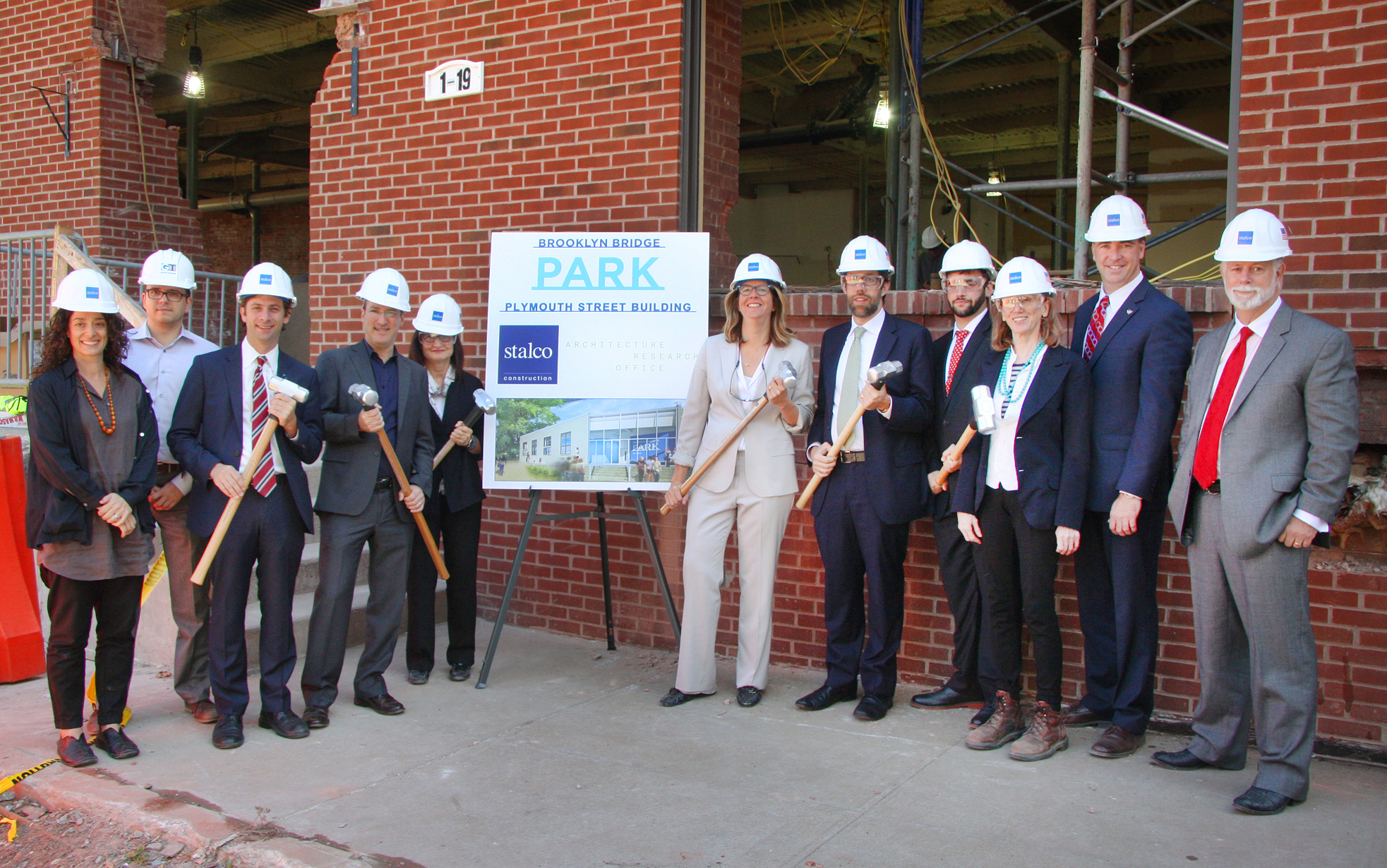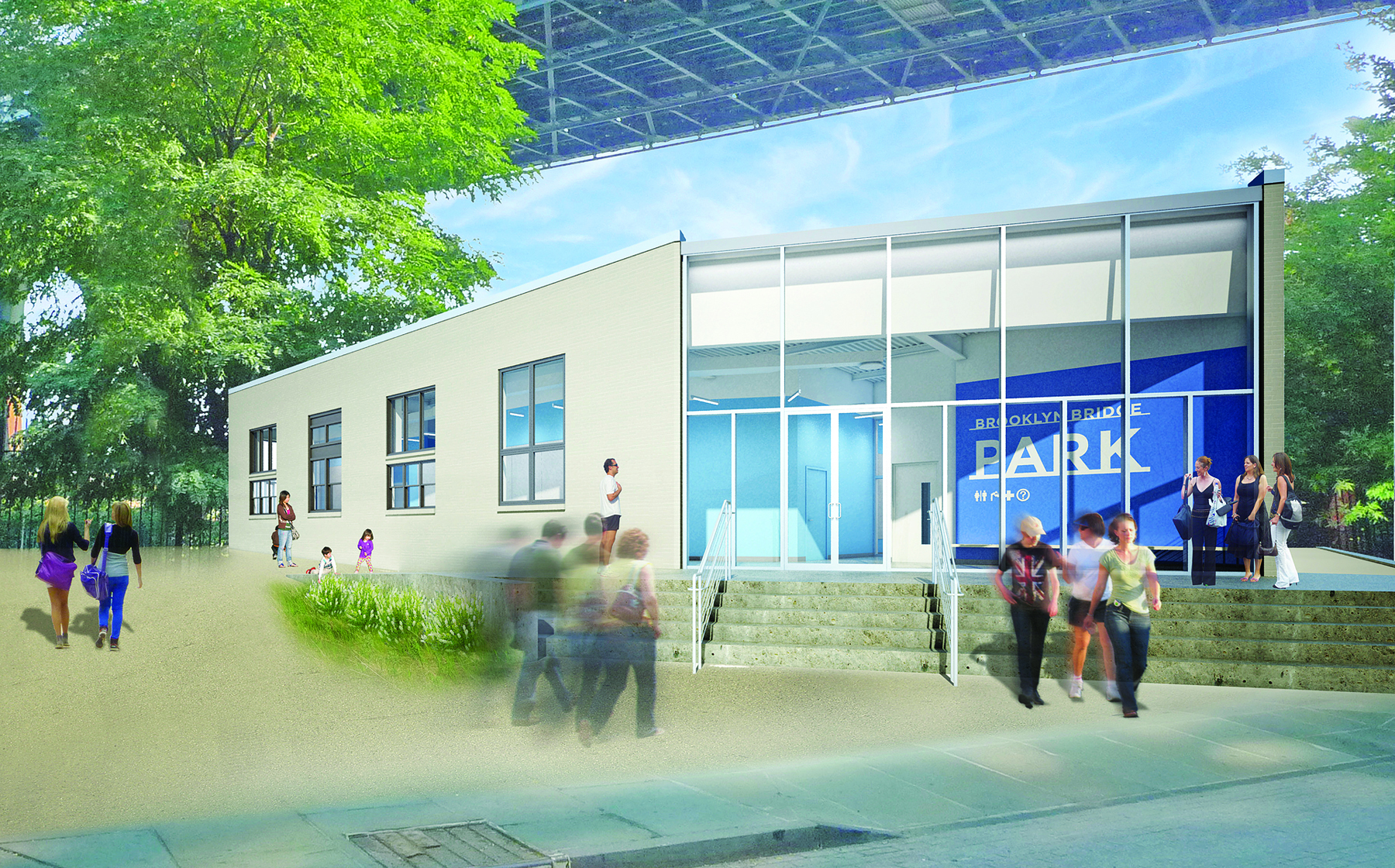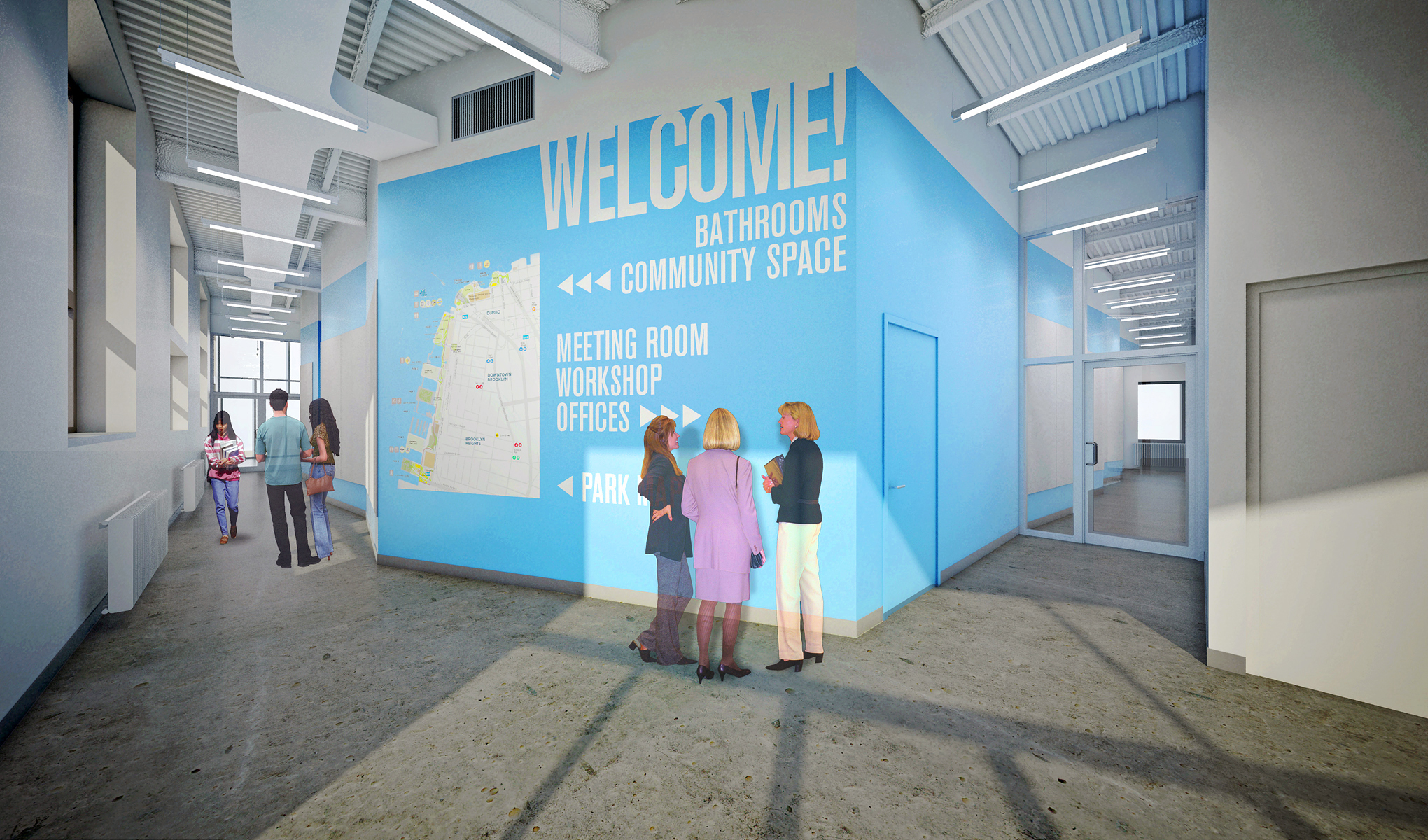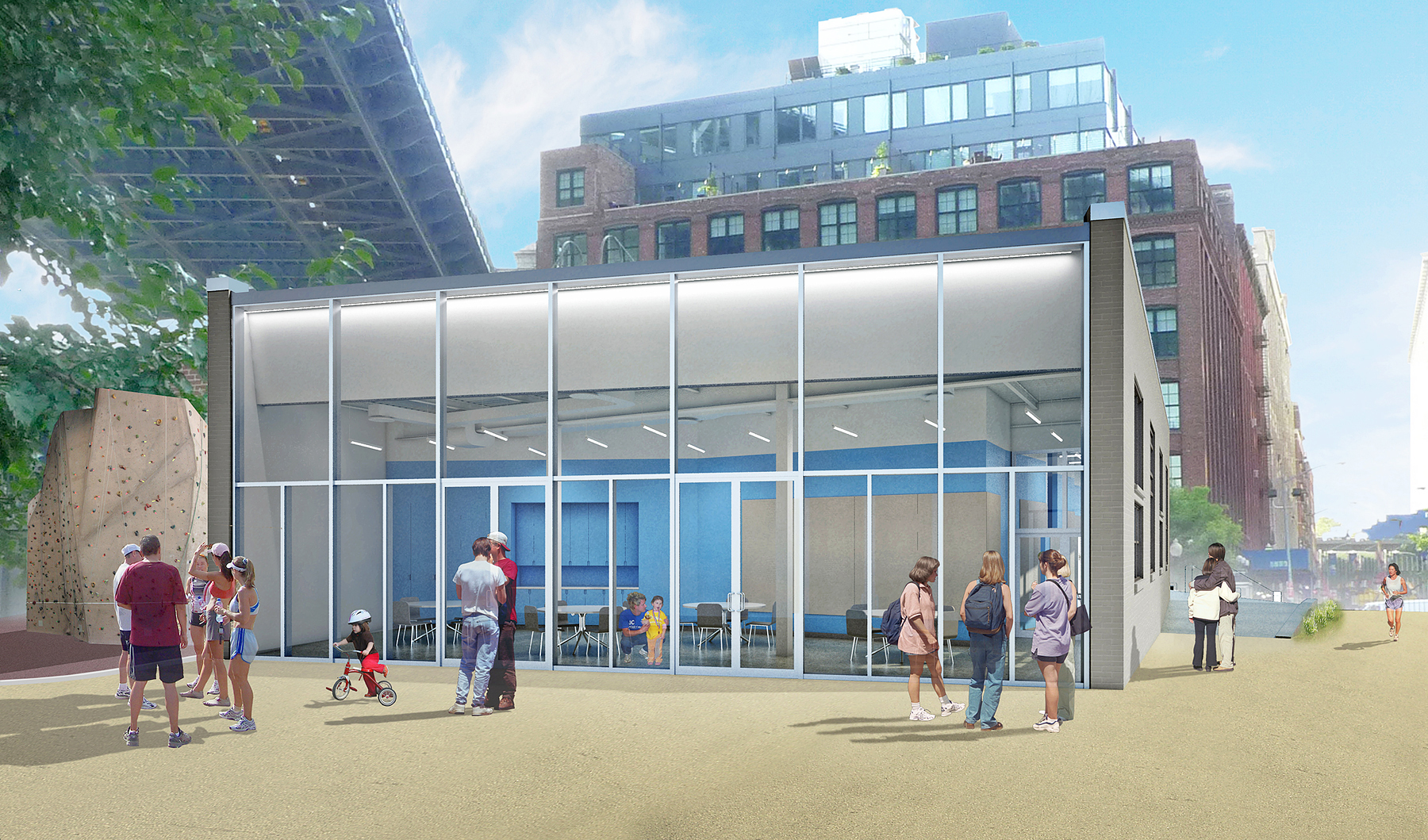The event, attended by community leaders and borough, city, and state politicians, included a ceremonial beginning of demolition of a section of the building to make space for a new glass wall that will open the interiors to the surrounding park. The ceremony culminated in BBP president Regina Myer, New York state senator Daniel Squadron, New York City councilman Stephen Levin, Brooklyn borough director of Capital Budget and Economic Development Kai Feder, BBP Conservancy Executive Director Nancy Webster, and Stalco Principal Kevin G. Harney and Project Manager Keith Ward demolishing a part of the wall with sledge hammers. The event marked the beginning of the main phase of the project, which is scheduled to open in the summer of 2015.
“The Plymouth Street Building is going to be a fantastic addition to Brooklyn Bridge Park, and I am excited to see it moving along so swiftly to completion,†said Regina Myer, president of BBP. “With its flexible community areas and educational facility, this space will provide important year-round programming opportunities for the local community and all park users.â€
"Brooklyn Bridge Park is a modern urban marvel, both in design and in creative use of our waterfront. I'm pleased to see progress move forward on this next phase that will advance the educational and community-building aspects of the park," said Brooklyn Borough President Eric L. Adams.
“Upon completion of the $3.6-million renovation, the building will serve the entire 85â€acre Brooklyn Bridge Park, one of Brooklyn’s most popular outdoor areas,†said Stalco principal Kevin Harney. “The structure is located on a 10,650-sq.-ft. site situated directly beneath the Manhattan Bridge in Brooklyn’s trendy DUMBO neighborhood,†he added.
“Today, we are announcing the very first permanent location for Brooklyn Bridge Park Conservancy's environmental educational programs. The building is striking, the facility will serve thousands, and I am proud to give it my support,†said New York City Councilman Stephen Levin.
“The project includes demolition of a portion of the main, one-story building previously used by NYCDEP, and two adjacent storage structures,†explained Stalco Project Manager Keith Ward. “Stalco will construct a new glass curtainwall on the west and south elevations, refurbish the original exterior brick walls, build a new storefront-type entrance and additional window and garage door openings, and completely renovate the interiors in order to create offices and community facilities,†he continued.
The building’s exterior will feature a glass and aluminum curtain wall and main entrance, with a portion of the wall constructed of soundproof glass. Stalco will build a new access door, windows, and a garage-type door in the brick wall of the building to provide access to a new compactor room. The upgrades will include a new reflective EPDM roof and all new mechanical, electrical, and plumbing (MEP) systems.
Stalco Assistant Project Manager Jeanette Macleod outlined technical challenges of construction work on a historic waterfront, noting that “the site is located in close proximity to the East River and near 19th century manufacturing and warehouse buildings, many of them converted to residential or commercial use. The project team will employ vibration monitors during construction in order to protect the surrounding historic structures and the landmark neighborhood.â€
The project’s challenges will also include incorporating significant changes to the building’s structure. “Construction crews will revise the structural system of the building to support the large new glass walls and a new concrete floor slab,†explained Stalco Superintendent Walter Baird. “The existing partial basement in the east side of the building will be cut back and a section of the concrete floor above it will be open to allow for installation of a new concrete beam to support the new floor and a steal beam that will support the glass curtainwall. A new concrete floor slab will be poured on top of the new beams. In addition, the roof above the glass wall will be revised as well to allow the glass to reach the roof parapet without obstructions. The roof membrane will be cantilevered on new bent steel outrigger plates welded to a series of square posts that will bear down on a new roof beam that will distribute the load to the brick bearing walls,†he explained.
The renovated, 11,300 s/f building will house a 300 s/f community room with a display area, an 800 s/f classroom for environmental education programs, a BBP maintenance space, a kitchen, two public bathrooms, a locker room, and a basement storage area. The interior finishes will include polished and sealed concrete floors, painted gypsum board walls, and porcelain tiles in the bathrooms. The environmental education classroom will feature a large aquarium and a “touch†water tank for interaction with marine animals.
In addition to Stalco Construction and Architecture Research Office, the project team includes owner’s representative Gardiner & Theobald, structural engineer Robert Silman Associates, MEP engineer AltieriSeborWieber, civil engineer Sherwood Design Engineers, lighting designer Lighting Workshop, and landscape architect Michael Van Valkenburgh Associates. Landscaping and site improvements will be performed under a separate contract.
Architecture and design
The project’s genesis lays in Brooklyn Bridge Park’s northbound expansion into the Main Street site, beneath the Manhattan Bridge. The expansion increased the need for visitor and maintenance facilities and the park decided to utilize a former NYCDEP storage and maintenance building to fulfill these needs.
According to ARO managing partner Stephen Cassell, AIA, “During the pre-design phase, the park’s leadership outlined the functional needs to be addressed by the redeveloped building: a community room, public bathrooms, an educational space for the Brooklyn Bridge Park Conservancy, and office and park maintenance facilities.†The Conservancy, which organizes environmental education classes and presentations for students from New York City’s schools and other visitors, does not currently have a permanent location for its programs.
The architectural team focused not only on accommodating the client’s spatial needs and merging the public and the private/park management functions of the facility, but also on seamlessly incorporating the building into the overall context of the park, landscaping, and streetscape. They decided to open the interiors to the site outside.
“We recognized the views of the East River, Manhattan and Brooklyn bridges, and the Manhattan skyline across the river as the most valuable assets of the site. The team decided to open these views to the adjacent Plymouth Street, which is frequented during day and night by local residents, workers from nearby businesses and offices, and tourists alike.
To achieve that, the architects opted for an uncommon solution of reducing the size of the original structure through removal of a corner in the southwest section of the building, thus opening views from the street towards the river, which were previously blocked by the structure. Trimming the envelope will also improve the pedestrian circulation in this section of the park.
The 28-foot-wide opening created by the removal of the corner will be equipped with an expansive glazed curtain wall spanning the height of the building and featuring the main entrance. The glazing will play an important role in opening the interiors to the park and views outside. The same solution, a 41-foot-wide glazed curtainwall, will open the interiors of the environmental workshop classroom in the northern section of the building to views of Manhattan, the river, and the Manhattan Bridge. This curtainwall will feature two entrances.
The remaining original exterior brick walls with a brick veneer will be painted grey to reduce the visual impact of the building on the landscape and highlight the signature two tones of blue color of BBP’s logo utilized extensively in the interiors, which will be visible through the curtain walls.
The site surrounding the building will receive new landscaping designed by landscape architect Michael Van Valkenburgh Associates, Inc., which also developed the entire park’s masterplan.
“The new interiors will feature economical, durable finishes that both accommodate the utilitarian, public function of the building and represent park’ branding through two tones of blue present in the park’s logo,†said ARO project designer Ethan Feuer. “The gypsum board walls in the environmental classroom and the public space behind the southwestern curtainwall will be painted blue as will be the long, public hallway alongside the southern side of the building. All spaces will feature 15-foot-high ceilings with exposed, light grey-painted metal decking, structural elements, and infrastructure.
Highlighting the structure’s community role, the hallway will be equipped with a continuous, 130-foot-long Homasote pin board for displaying announcements, park information, and student artwork.
The bathrooms will vary from the blue color scheme and feature grey three-inch-by-six-inch “subway†tiles on three sides, bright yellow tiles on one wall for contrast, and steel sinks and partitions.
The flooring will be polished concrete, with the addition of an epoxy coating in the main classroom/workshop.
Brooklyn Bridge Park history and current programs
The site of Brooklyn Bridge Park was once a thriving industrial waterfront. In the 1950's, however, shipping in NYC began a steady decline, while the construction of the Brooklyn-Queens Expressway created an approximately 60-foot-high barrier that isolated the East River waterfront from the community and restricted waterfront access. The Port Authority ceased cargo operations in 1984, and in 2002, Governor George Pataki and Mayor Michael Bloomberg dedicated state and city funding providing for the park's construction and for the creation of Brooklyn Bridge Park Development Corporation, which eventually became the Brooklyn Bridge Park Corporation - the not for profit entity responsible for the planning, construction, maintenance and operation of Brooklyn Bridge Park.
Brooklyn Bridge Park is the result of extensive community planning and grassroots advocacy lasting more than 20 years. Designed by Michael Van Valkenburgh Associates, Inc., the park was planned with several goals guiding its development, including: returning the waterfront to public use, creating a multi-use civic space, and reconnecting with adjacent neighborhoods. Among the park’s many features are: three activated piers (Pier 1, Pier 5, Pier 6); Jane’s Carousel, a historic and beautifully restored carousel built in 1922; boat ramps; a parkwide greenway; a pebble beach; fishing stations; sand volleyball courts; waterfront promenades; a salt marsh; picnic tables and grills; playgrounds; sports fields; a pop-up pool; and Squibb Park Bridge – a dynamic structure that provides a direct and dramatic entry point to the park from the promenade above.
The Brooklyn Bridge Park Conservancy (the Conservancy) provides over 450 free cultural, educational, and recreational events in the park. Additionally, the Conservancy’s environmental education program serves over 8,000 students per year from over 50 New York City schools and free day camps, using the park as a living classroom to promote hands-on, investigative learning.
Brooklyn Bridge Park serves thousands of visitors on any given day, attracting 108,000 people during an average summer weekend. The park has had a profound impact on several of Brooklyn’s most vibrant residential neighborhoods, including the Columbia Street Waterfront Corridor, Brooklyn Heights, and Dumbo. For example, the Columbia Street corridor community has seen increased residential sales as a result of the success of nearby Pier 6.
Future plans for the park include additional calm water zones for non-motorized boating, basketball and handball courts, multi-use lawns, a full size roller skating rink, and a marina. Once complete, BBP will span a total of 85 acres along the East River waterfront, making the project the most significant park development in Brooklyn in more than a century.
Brooklyn Bridge Park received the 2014 National Planning Excellence Award for Urban Design from the American Planning Association.
Photo 1 Caption: Shown (from left) are: BBP Conservancy director of Educational Programming Kara Gilmour; Gardiner & Theobald cost manager Justin Skeels; New York City councilman Stephen Levin; Architecture Research office managing principal Stephen Cassell, AIA; BBP president Regina Myer; BBP Conservancy executive director Nancy Webster; New York State senator Daniel Squadron; Brooklyn borough director of capital budget and economic development Kai Feder; BBP VP of capital operations Patricia Kirshner; Stalco project manager Keith Ward; and Stalco principal Kevin Harney. Photo by Peter Wilk/Wilk Marketing Communications

Thanks for Reading!
You've read 2 of your 3 guest articles
Register and get instant unlimited access to all of our articles online.
Sign up is quick, easy, & FREE.
Subscription Options
Sign up is quick, easy, & FREE.
Already have an account? Login here










